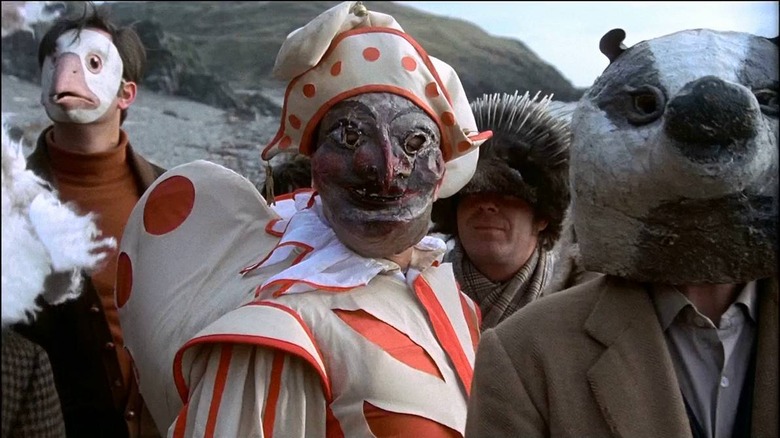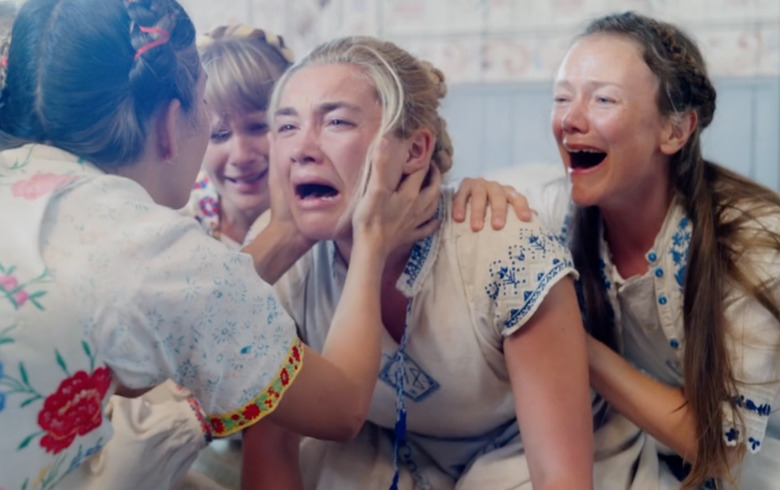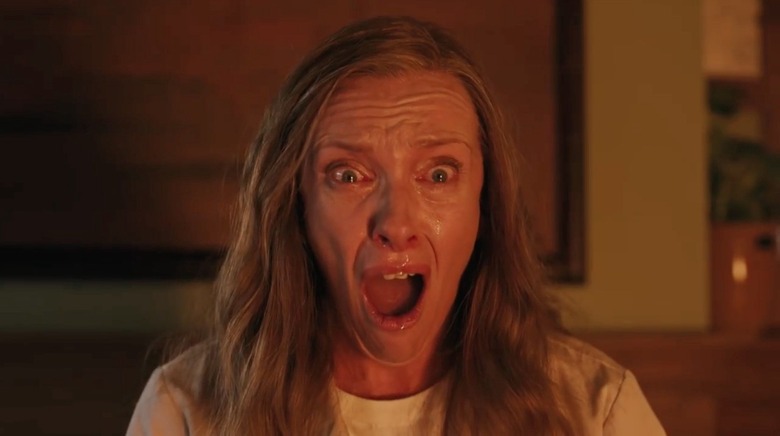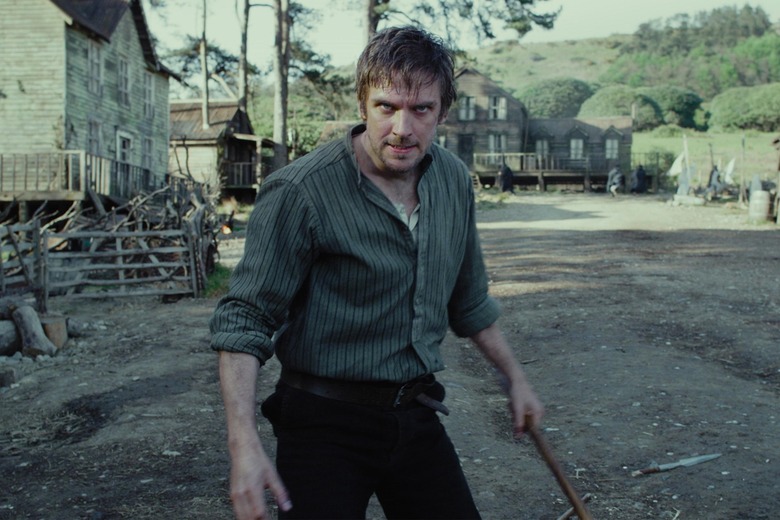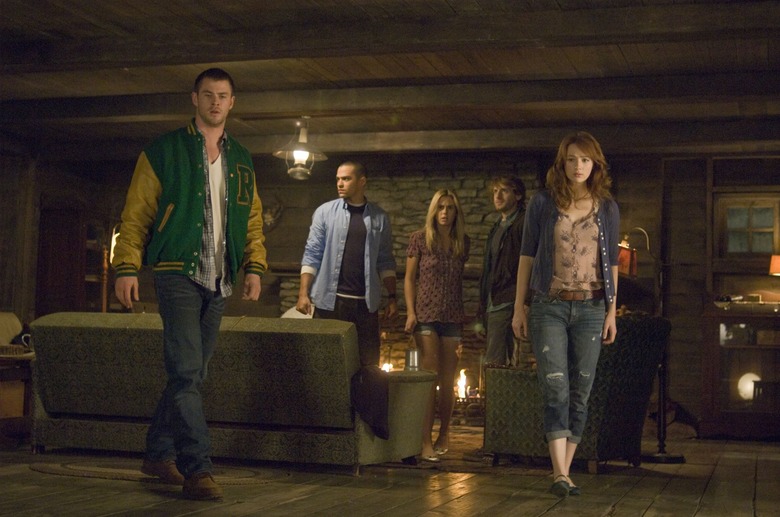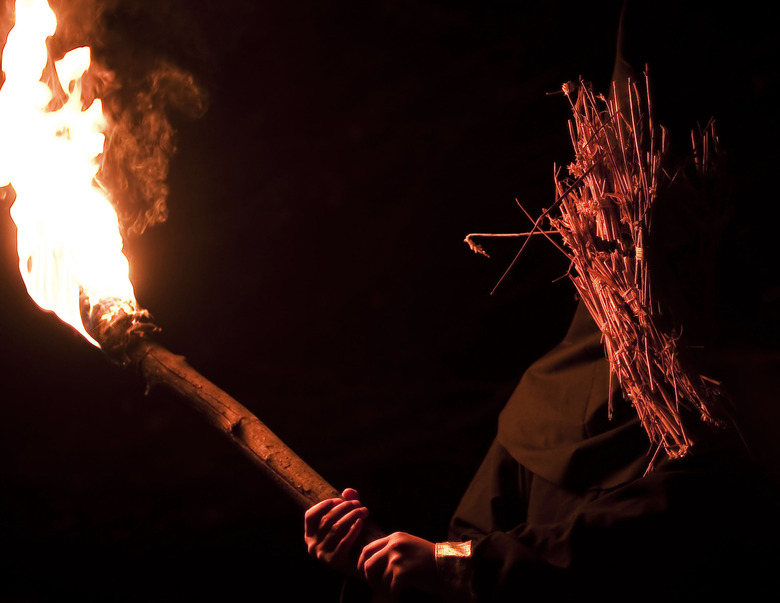Chasing 'The Wicker Man': 'Midsommar' And Five Other 2010s Films About Secret Cults And Human Sacrifice
Since 1973, various horror films have tried to replicate the shock of the prototypical human sacrifice movie, The Wicker Man (not to be confused with its gonzo 2006 remake, starring Nicolas Cage, which is perhaps best remembered for the immortal, memeified line, "Not the bees!") Even the late Robin Hardy, director of the original Wicker Man, went back to the well in 2011 with The Wicker Tree. Most movies, including that one, have failed to recapture the terror of the iconic moment when the protagonist turned sacrificial victim burns alive, surrounded by cult members. However, the 2010s have been bookended by a number of interesting horror films, each of which has managed to reframe the Wicker Man model in different ways.
One of those films, Midsommar, hits Blu-Ray on October 8. Writer-director Ari Aster has called Midsommar "an apocalyptic break-up movie." Speaking with Empire, he talked about how he tried to avoid The Wicker Man's influence, saying, "I think what [Midsommar] tries to do is point to The Wicker Man and set up expectations native to that film, then take a left-turn from there and go somewhere surprising."
That's a quote that could apply to other films on this list, too. Of course, this man made of wicker is not escaped easily. In some ways, he's like the Gingerbread Man: every horror movie that deals in similar tropes seems to be chasing him. Here, we'll chase The Wicker Man back through his own movie, then back through Midsommar and five other horror films of the 2010s. How have recent fright flicks approached the timeless subject of secret cults and human sacrifice?
Note: to really do a full comparison between these movies and The Wicker Man, we'll need to delve into spoilers, so if there's a film you haven't seen, go watch it first, then come back to that section on the list below.
The Lone "Fool-Victim" in The Wicker Man (1973)
In The Wicker Man, the protagonist, Sergeant Howie (Edward Woodward), comes to the secluded Summerisle alone. That's a key difference between him and the protagonists of most of the other movies we'll be talking about here. Howie actually flies his own police seaplane in, with no partner or co-pilot. He then broadcasts his arrival with a megaphone.
At the Green Man Inn, where he goes for room and board, Howie wastes no time breaking up the party and telling the islanders that he's there "on official business." As he pursues his investigation into the disappearance of a girl named Rowan, he does so without allies. It leads only to his undoing, not anyone else's.
Throughout the movie, Howie is continually aghast at the expressions of Celtic paganism he sees among the islanders. At night, he frowns upon their bawdy tavern songs, only to go for a walk and witness couples having sex in public. In the morning, he sees boys gathering around the maypole, singing about trees and birds and human reproduction, while in a nearby classroom, a teacher instructs the girls that the maypole is a phallic symbol.
Through flashbacks, we see the churchgoing Howie act as a Gospel reader and partake of communion wafers and wine. In his room at the inn, he kneels and says his prayers before bed. However, despite his officious manner — or perhaps because of it — he is tempted by the siren's song. In this case, the siren's voice belongs to the innkeeper's buxom daughter, Willow (Britt Ekland, overdubbed by Annie Ross), who dances naked in the next room while singing to him and knocking on the wall.
It's a memorable sequence in this strange folk horror musical, second only to the shocking conclusion where the titular wicker man makes his appearance. The morning after her naked song-and-dance number, Willow laments to Howie, "I thought you were going to come and see me last night. I invited you." He mentions that he's engaged to be married, but it's not even clear, in the context of the 88-minute theatrical cut, if this is just an excuse or if he really has a fiancee waiting for him back on the mainland. Either way, he says he doesn't believe in sex before marriage.
The funny thing is, this is what seals his doom. The Wicker Man predated John Carpenter's Halloween by half a decade, but in retrospect, it offers up a fascinating inversion of the slasher-movie trope that Halloween helped propagate, whereby the promiscuous die and the virgin lives.
Scottish policemen don't fit the final-girl archetype. It's his insistence on standing apart from the islanders in hypocritical reproach, despite sharing their lustful nature, that ultimately condemns Sergeant Howie in The Wicker Man. Numerous times, they warn him off of the May Day celebration. He's meddling in affairs that his Christian-centric brain lacks the capacity to understand. In the end, the people he's judged come together and judge him as "one of the great fool-victims of history." When he meets his martyrdom, he's isolated from the group, which sways happily as the wicker man goes up in flames with him and other sacrificial animals inside it.
Sacrifice as Breakup Revenge in Midsommar
Of all the films on this list, Midsommar is the one with perhaps the most consistent emotional through line. That's presuming one is able to identify with the sweet but wounded main character, Dani, played by Florence Pugh. All it takes to identify with her is a bit of empathy, and really, that's what this movie is about. The fiery sacrifice Midsommar builds up to is more about Dani letting go of a bad relationship, finding profound, crazed empathy in a new community after losing her family.
From the very beginning, Dani's boyfriend, Christian, seems wholly uninvested in their relationship. To his grad school friends, she's clingy and calls him on the phone too much. They encourage him to break up with her, but she's going through a lot: first, dealing with a mentally ill sister, then, dealing with a horrific murder-suicide that leaves her parents and sister dead in a house filled with carbon monoxide.
Dani has an intuition that something is wrong but Christian isn't emotionally present enough to take her concerns seriously. He's only there for her out of half-assed obligation. He and his friends even plan a trip to an isolated rural commune in Sweden without telling her. There's a moment when she sits down and starts talking to Pelle, the Swedish guy who invited them, and it feels like the first time that someone really sees her and is fully engaged by her presence. Later, Pelle will ask her if she's ever "felt held," his words ringing with insight, because she plainly doesn't have the love and support she needs.
In the commune, which is home to — you guessed it — a human-sacrificing cult, Dani and the boys witness two elders leap to their deaths from a cliff. One of them survives the fall, which immediately sets off empathetic wails in the crowd of cultists. Naked women also stand around and moan empathetically as Christian works to impregnate a girl from the commune. When Dani catches him in the act, they kneel on the floor with her and share her cries of anguish, their faces displaying raw, powerful emotion in direct contrast to Christian's characteristic, blank-eyed expression.
It's a gut-wrenching scene. We've just seen Dani dancing around the maypole, being crowned the May Queen like Rowan in The Wicker Man, but now her boyfriend has casually betrayed her, just as he casually betrayed one of his friends when he decided to steal his thesis. By the end, we're so caught up in the delirium of Midsommar and Dani's plight that it feels like poetic justice when we see the appropriately named sacrifice victim, Christian, stuffed into a bearskin and set on fire.
On some deranged level, it's his rightful comeuppance. Decked in flowers, Dani's gone from vulnerable to vengeful, but she manages a smile. Were it not for the fact that several other people died — and the fact that Christian is supposed to be someone Dani loves — this almost might qualify as a happy ending.
The Cult as Family-Destroyer in Hereditary
Midsommar is obviously ripe for a double feature with last year's Hereditary, in which Aster utilized "the perspective of the sacrificial lambs" to explore a family unknowingly manipulated by a demon-worshipping cult. Whereas The Wicker Man builds inexorably toward its sacrifice on the beach, Hereditary has an ending that might seem to come out of left field if you're not wired into the esoteric hints of a cult on the first viewing.
Toni Colette's histrionic matriarch, Annie, certainly isn't. Yet in hindsight, the writing was on the wall all along: literally, with cryptic words like "satony" appearing on the walls of the life-size dollhouse she and her family inhabit. What Hereditary does is domesticate the usual cult scenario, seeding in a backstory about an evil grandmother who groomed her own children and grandchildren to be host bodies, or sacrifices of a sort, for a demon.
Whereas Dani is responsible for the death of her boyfriend, Annie is responsible for the death and/or possession of her whole family. Before it's even happened, she tells a support group, "I just sometimes feel like it's all ruined. And then I realize that I am to blame. Or not that I'm to blame, but I am blamed."
It's, well, hereditary. Annie's inherited a legacy of madness from her mother without knowing the cause. The cult, in this case, is merely an externalization of destructive inner forces, operating beyond one's ken or control. Taking a cue from the classroom scene in Halloween, Hereditary sketches this theme early on when it has students talking about how characters in the Greek tragedy Herakles are "pawns in a horrible, hopeless machine."
Like Herakles, Annie refuses to look at all the signs that are being handed to her. She sends her daughter to the party where the chain of events leading to her nightmarish decapitation will occur. She also leads the love of her life straight to his death: her husband goes up in flames, just like Sergeant Howie. To say nothing of her own sawed-off head ...
Then there's her son, the young man destined to wear the crown of Paimon, one of the kings of hell. "Peter is in danger, and I started it," Annie realizes. She started it just by giving birth to him, even though that's something she never wanted to do. At the dinner table, she lashes out at him; in his bedroom, she sees him being devoured by ants like her daughter's head. In the end, Peter stands heir to the same forces that destroyed his family. "Mo' pain" is an anagram for Paimon.
Familiar Tropes, New Settings in Apostle and The Ritual
Type in one title or the other in your Netflix search bar and you'll probably see Apostle and The Ritual pop up right next to each other. In recent years, the streaming giant has gotten in on the Wicker Man chase by distributing these two films, each of which transplants the familiar cult sacrifice story to a new location.
Apostle, starring Dan Stevens, began streaming last October. Stevens plays Thomas Richardson, a former Christian missionary who ventures to a remote island — off the coast of Wales, this time, instead of Scotland — to rescue his sister from a cult.
What sets Richardson apart from Sergeant Howie is that he's lost his faith and he's able to blend in better, even form some alliances, on the island. He goes there masquerading as an initiate, only to discover that the island's fertility is sustained through blood sacrifice. This time, the cult members willingly offer up their own blood in jars. There's no need for the lives of outsiders to be sacrificed ... but that doesn't mean people don't still die in gruesome public "purification" rituals.
Filmmaker Gareth Evans (The Raid) already showed us one Jonestown-esque cult when he co-directed "Safe Haven," a segment in the 2013 horror anthology V/H/S/2. In Apostle, he makes the actual deity that the cult worships more of a character than we've seen in other movies. She's a decrepit goddess who the cult leaders keep subsisting in captivity. This kind of movie doesn't often breed self-sacrifice on the part of its doomed cult victims, but that's exactly what happens when Richardson becomes one with the grass and replaces said goddess as the island guardian.
Directed by David Bruckner, another alumnus of the V/H/S series, The Ritual began streaming on Netflix in February 2018. The movie follows four friends hiking the King's Trail in Sweden, who decide to cut through the woods when one of them suffers an injury. It's equal parts Blair Witch and Wicker Man, with the cult not showing up till later in the movie. As you might expect, there's also a cabin in the woods, complete with a creepy statue in its attic, similar to the climactic treehouse statue in Hereditary.
Rafe Spall plays Luke, who is haunted by his failure, months before, to save the fifth friend in the group during a robbery. He'll soon witness his last surviving friend sacrificed to the Jotunn, an elk-like god who bears the distinction of being the bastard son of Loki (the version from Norse mythology, not the Marvel Cinematic Universe).
Luke faces the choice of becoming a living sacrifice himself or bowing before the Jotunn, in which case he can join the ranks of the cult's immortal members—some of whom cling to existence as barely sentient mummies. He elects choice "C": to escape back to civilization. It's more of a choice than Sergeant Howie ever got.
Sacrifice Gets Meta in The Cabin in the Woods
Within the first fifteen minutes of The Cabin in the Woods, a bird flies into a force field. Clearly, this isn't your typical teen slasher movie. Here, the cult, as it were, has developed into a full-blown global conspiracy. Allusions are made to its crude beginnings. "Remember when you could just throw a girl in a volcano?" asks Bradley Whitford's snarky control room engineer.
He and his colleague (Richard Jenkins) help orchestrate an elaborate, tech-enabled, ritual sacrifice to appease the Ancient Ones: giant movie gods who sleep below ground and are roused to anger when the horror films staged in their honor don't adhere to genre convention. These two characters are essentially stand-ins for director Drew Goddard and co-writer Joss Whedon, whereas the Ancient Ones represent the audience.
Like Midsommar and Hereditary, which received a C+ and D+ CinemaScore, respectively, The Cabin in the Woods wasn't what some filmgoers were expecting on opening night. While it holds a 91% Tomatometer rating, it earned a "C" CinemaScore overall. Women notably gave it a D+.
Perhaps they didn't take kindly to its all-knowing geek male perspective or its self-aware signaling of "virgin" and "whore" archetypes. The scene where the boys yuk it up over the speaker phone does verge on being self-indulgent in terms of its irreverent wit. In this movie, it's the pot-headed, fifth-wheel geek who reappears at a crucial moment to save the final girl ... only for her to turn around and show her appreciation by pulling a gun on him at the end. He's the one who first figures out that he and his friends are at the mercy of "puppeteers" when they unwittingly enter a horror movie set-up.
At this point, cabin-in-the-woods movies form their own sub-genre of horror. While The Cabin in the Woods might be more indebted to Sam Raimi's The Evil Dead, it does bear some structural similarities to The Wicker Man. Here again, our heroes venture to a secluded location, where they find themselves caught up in a broader human sacrifice scheme. This time, the Virgin and Fool aspects of Sergeant Howie are broken down into two separate characters. We also meet a blonde Whore, a letterman-jacketed Athlete, and a sometimes-bespectacled Scholar.
The catch is that none of these characters fits their trusty, two-dimensional labels. The Athlete, played by Chris Hemsworth, is actually a sociology major who is on full academic scholarship. He has to be manipulated into alpha-male behavior from the control room. Pheremone mists and subliminal whispers help rig the game against him and the other unknowing players.
This is one of the things The Cabin in the Woods addresses: how people in cheap horror flicks act out-of-character and do things no sensible person ever would, in order to feed the monster (sometimes literally) and keep the entertainment ritual going. It's all part of the movie's meta-commentary, which takes the genre fan on an elevator ride for the ages and builds to a big, hell-on-earth finish. Along the way, there are some fun nods to J-horror and other sub-genres, and through it all, there's an underlying morality about free will that makes you stop and think before some zombie redneck torturer pops up again with a bear trap to yank you back into the action.
Thanks to a sudden werewolf attack, the Virgin has time to rethink her decision to kill the Fool in The Cabin in the Woods. Rather than gun down her friend, the last intended sacrifice victim, she goes along with his decision to let the whole world die. Humanity has had its chance; maybe it doesn't deserve to live. (Yet one can't help but think, don't they have families back home, people they care about?)
By choosing the immediate and personal over the faceless and universal, they force a higher body count and the time-honored sacrifice ritual reaches new heights of collateral damage. If you still need a killer cult fix after this movie, Goddard employed a proper one, led by Hemsworth, in his 2018 sophomore effort, Bad Times at the El Royale.
The Hitman Crowned Cultist in Kill List
So much of horror involves dark forces invading safe spaces: haunting the house, making suburbia scary. In this respect, Ben Wheatley's Kill List mirrors Hereditary, insofar as it sees a spouse and parent allow a cult to invade his domestic sphere. The difference here is that it's the husband and father and he happens to be a contract killer.
Jay (Neil Maskell) is one brutish half of a two-hitman team. He and his partner, Gal (Michael Smiley), amble through hallways like schlubby British versions of Vincent Vega and Jules Winnfield. Unbeknownst to Jay, the cult has already infiltrated his house when he's hosting a dinner party and Gal's new girlfriend excuses herself to go etch arcane symbols on the back of the bathroom mirror.
She also steals a tissue with his blood on it. That's never a good sign. Nor is it a good sign when a new client suddenly slashes Jay's palm at a hotel sitdown, sealing their contract for three kills with more of his blood. The first two names on Jay and Gal's kill list — a priest and a snuff film "librarian" — weirdly thank Jay, even as he shoots and hammers them into oblivion like the nasty piece of work he is.
Throughout its 95-minute running time, Kill List seeds in clues like this that there's more going on than meets the eye; but I have to confess that the first time I saw it, its Wicker Man turn at the end seemed opaque, almost shoehorned in. Ambient music laced with unsettling whistles and vocal effects helps create an air of dread while the movie goes through its paces as a pseudo-realistic hitman drama. If you go back and rewatch it, however, its jagged, Faustian spine becomes more visible.
An ex-soldier traumatized by a mission in Kiev, Jay's life is already beset by financial problems and marital discord when he makes his deal with the devil. Like the cultists of Summerisle, he's not above antagonizing the occasional Christian, either. Ben Crompton (Dolorous Edd on Game of Thrones) cameos as the leader of a table full of them. His caterwauling acoustic guitar rendition of "Onward Christian Soldiers" leads to a confrontation with Jay in the hotel dining room. "God loves you," he says, to which Jay menacingly replies, "Tell God from me that if you're the type of people he hangs about with, stay out of my way."
As Jay unravels and becomes more violent, we get the sense that the cult is subtly remaking his life in its image. It switches out one of its members for his regular doctor, a la Rosemary's Baby, and eventually it manages to put a knife in his hand and have him direct his homicidal aggression at his own family. The film culminates in Jay's fight to the death with a "hunchback," the disguised form of his son strapped to his wife's back.
Chased through claustrophobic tunnels and surrounded by twig-faced figures that we've heard squeal like demons, the unrepentant killer dances shirtless in the firelit wilderness of night. By now, Jay has so completely lost his grip that he lacks the ability to discern family members from foes, until it's too late and he's already stabbed them repeatedly. Their bodies join the pile of sacrificial loved ones from Aster's films, and what's left is a twisted menagerie of unsuspecting cult recruits.
Like Dani in Midsommar, Jay is indeed left standing as part of the cult at the end. Whereas she smiles, liberated from her dependence on an emotionally unavailable boyfriend, he can only look on in stupefaction as his wife dies with a laugh, perhaps because she, too, is now liberated from their dysfunctional marriage. Wicker masks and flaming torches serve as visual callbacks to The Wicker Man.
The thread that binds several of these post-Wicker Man films is how they shift guilt onto their main characters, making them complicit in other people's deaths. It's horrifying enough to be culpable for one's own demise. It's even more horrifying to victimize someone close to you.

